Mushroom Monday - IN THE RICH AND COLORFUL COASTAL ECOSYSTEM - Part Four
After the Fungi Friday episode, the journey through the fungi filled coastal forest continues with a collection of mostly larger mushrooms ...
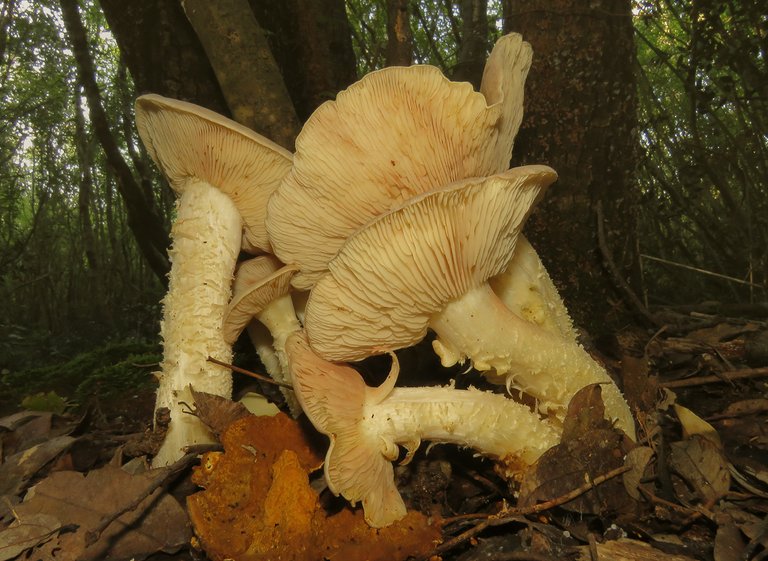
... that look kind of more appropriate under the thematic umbrella of the Mushroom Monday.
The mushrooms here come in many sizes ... here you can see some pretty massive ones.
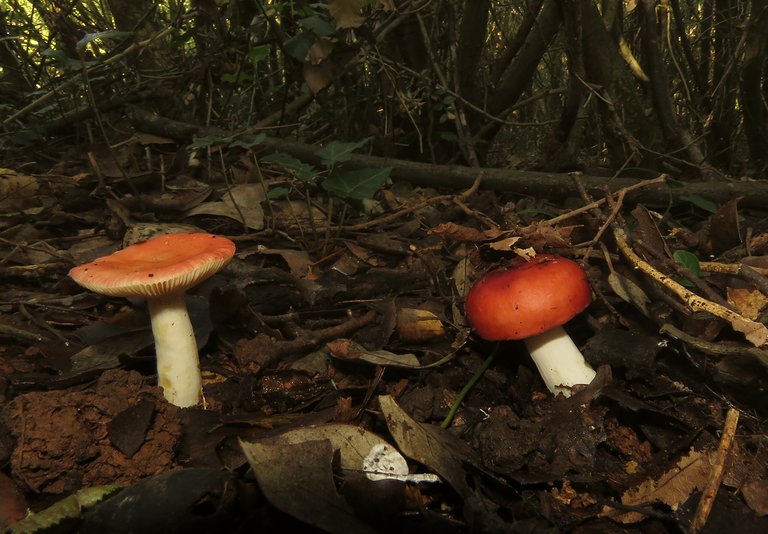
These colorful red Russulas ...
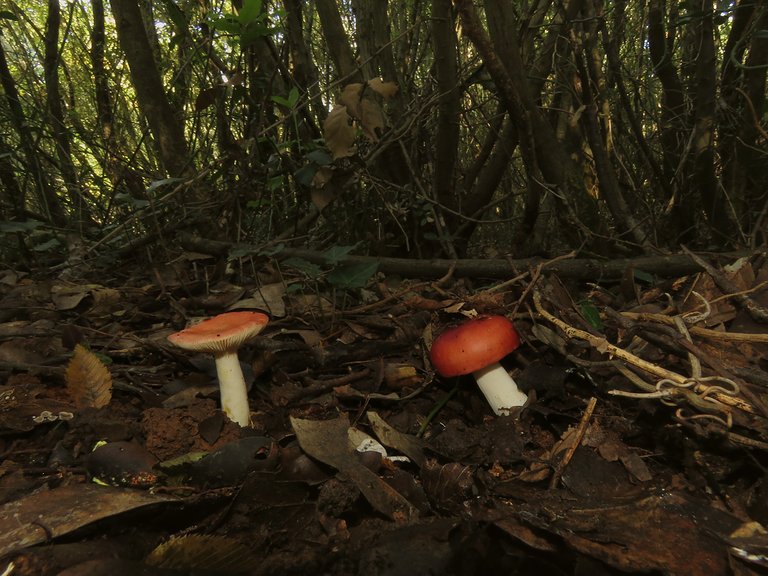
... are considerably smaller ...
... and this fragile pale umbrella is very small.
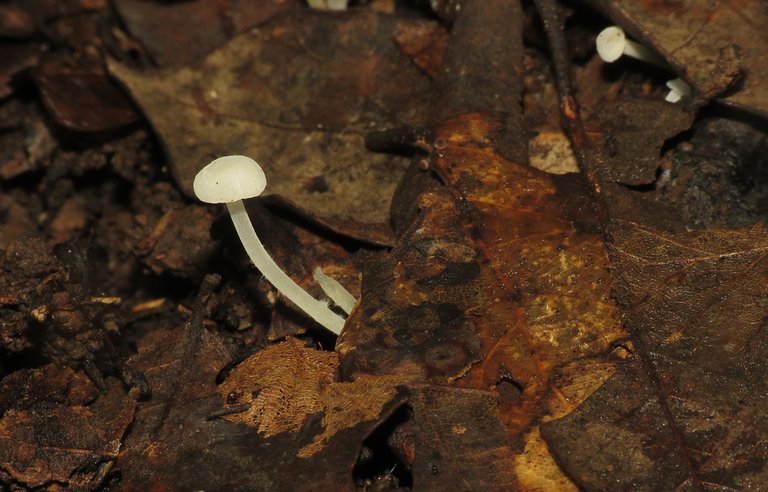
This could be some Hemimycena species ... Hemimycena is a widespread genus of small, pale mushrooms from the Mycenaceae family ... and they look approximately like this on many photographs throughout the internet ... but who knows ...
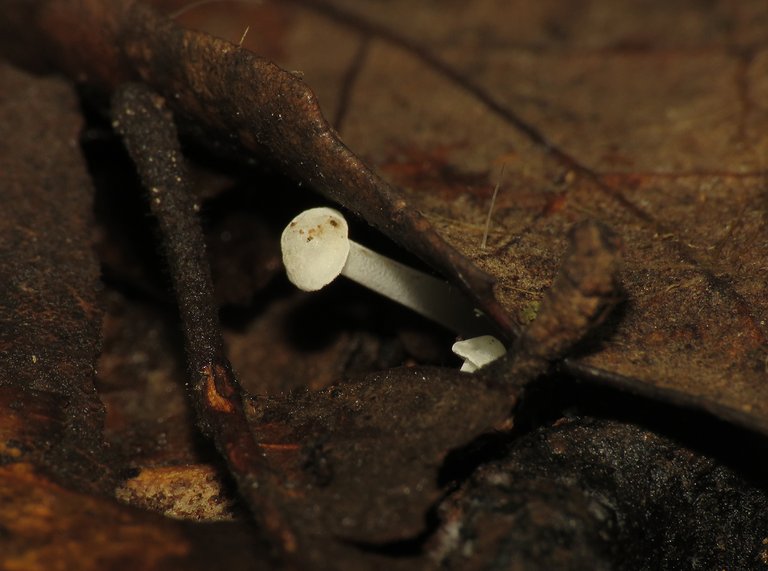
... anyway, I like the way they look in contrast with dark brown foliage on the forest floor ... this one is peeking like a little ghost from underneath the rotting leaf.
Mushrooms on this enlargeable photograph are similarly fragile and pale ... but considerably bigger ... maybe it's another species ... and again - who knows is all I can tell you, as some kind of conclusion.
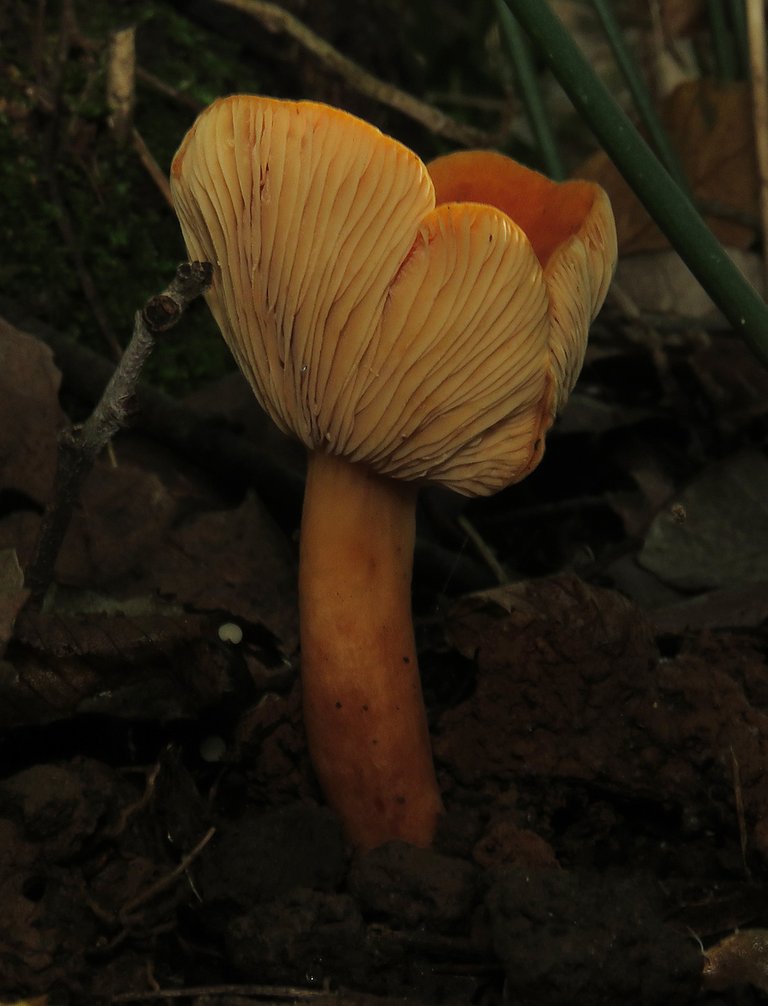
When photographing this Lactifluus volemus, I noticed a small twig leaning on the mushroom, on the first shot I took. Since I was in a slightly OCD mood, that bothered me ... so I decided to take another shot without that twig.
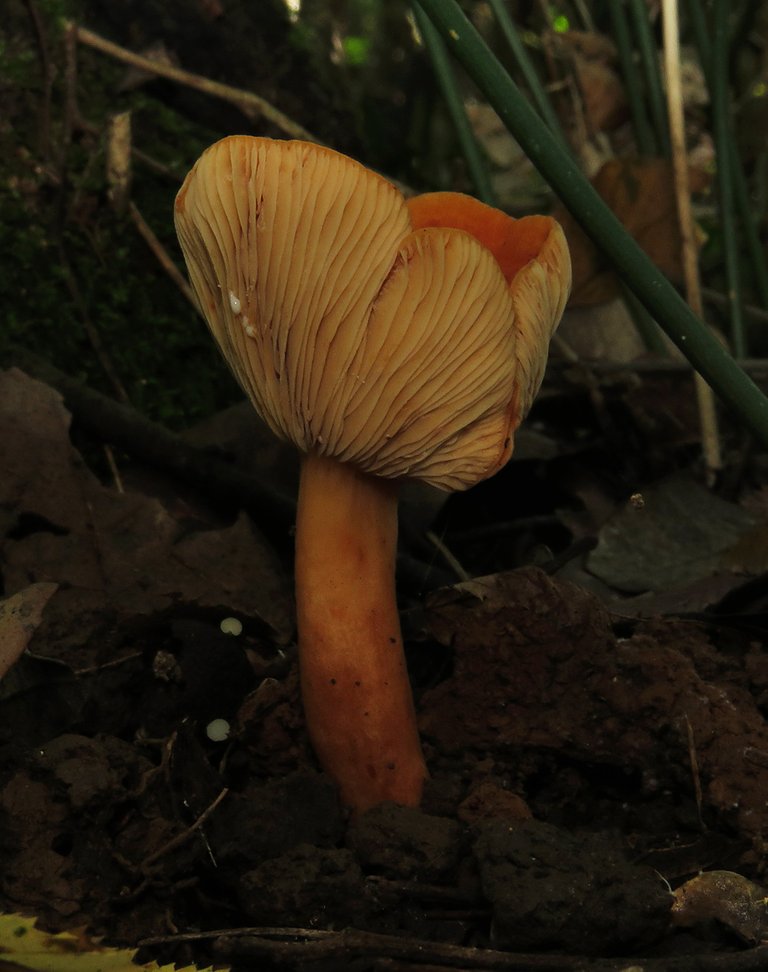
While removing the twig I scratched the mushroom very slightly ... but enough to show why is that Lactarius word part of its scientific name ... a few drops of dense, milk - like liquid appeared on the small, superficial wound.
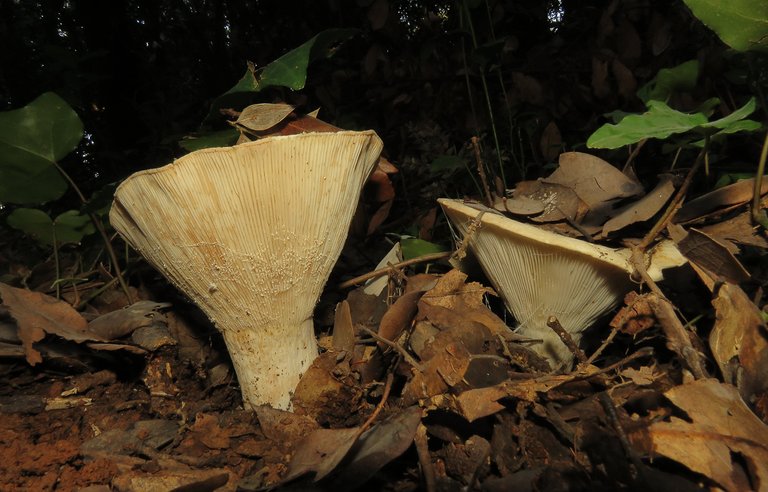
Here you can see two large Russulas of the Russula delica species. These mushrooms are generally considered edible but barely, having an unpleasant taste ... in some classifications they are even listed as inedible. I can't tell you anything from my experience - never tried to eat them. Are they a misunderstood delicacy ? An acquired taste ? Or simply one of the many inedible mushrooms growing in these woods ... well, who knows ...
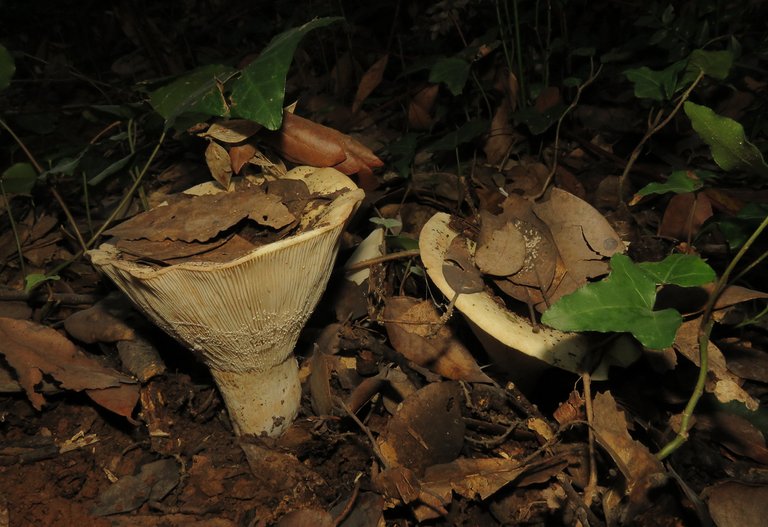
I took this second shot just to show you the fallen leaves on their trumpet - like caps.
Here is another red Russula ... probably the slightly poisonous Russula emetica ... but I'm never sure with these red - cap Russulas.
Quite a few colorful species of this Genus Russula, sometimes come in this pale, confusing version. This could be the Russula vesca ... or russula virescens ... but ... you guessed it ? :D Who knows ...
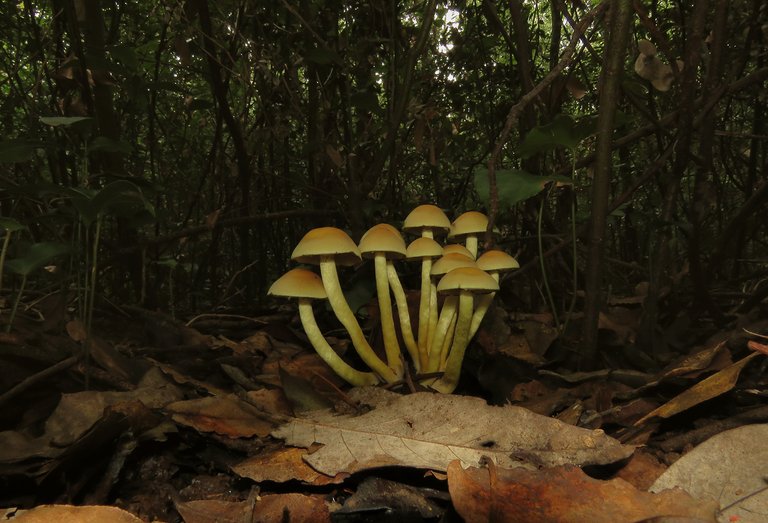
While photographing this colorful cluster of poisonous Hypholoma fasciculare mushrooms ...
... I found another Russula ... the clearly edible and easy to identify green Russula - Russula aeruginea.
Hypholoma fasciculare mushrooms ... commonly known as sulphur tufts, are usually found on rotting trunks of broadleaved trees ... but it looks like this group is sprouting from the soil ...

... it looks kind of strange ... but is quite normal, actually ... because ...
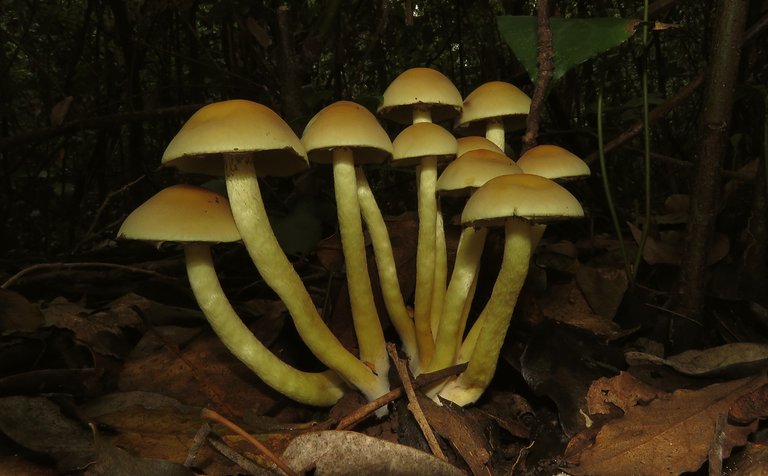
... this species can also grow on dead roots of the same kind of trees ... rotting roots near the surface, hidden by the layer of fallen leaves. Among all these fully or almost fully developed mushrooms ...
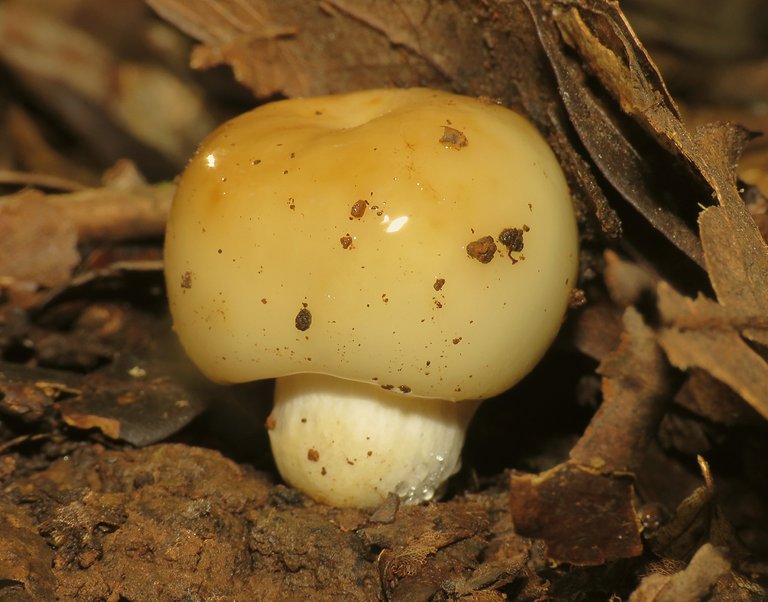
... I photographed also this small, undeveloped one, at the beginning of its cycle ... it's another Russula, very probably the Russula ochroleuca.
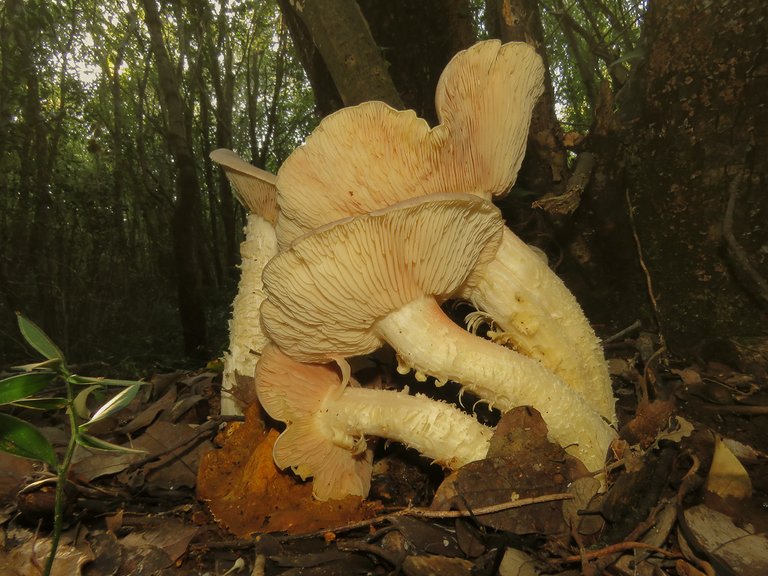
While sitting on the wet ground deep in the forest, concentrated on taking pictures of this stunning seasonal abundance ...
... mosquitoes were feasting on me. This one's abdomen is nicely filled with my blood. If you compare this picture with the following one ...
... you'll notice that the mosquito's blood-red abdomen got more swollen in the short fragment of time in between two shots. I was shooting with the camera in one hand, while the mosquito was comfortably drinking on my other hand.
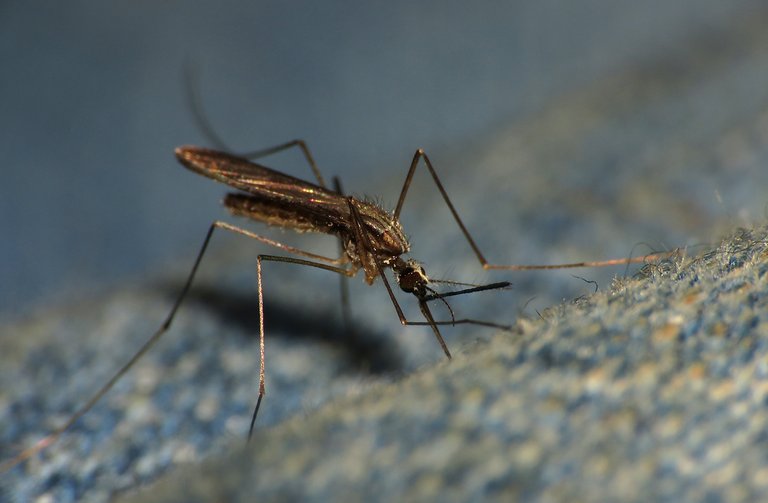
They were very hungry and aggressive ... trying to bite even through the clothing ... unsuccessfully for the most part. To take a break from the annoying mosquitoes ...

... I went on the open ...
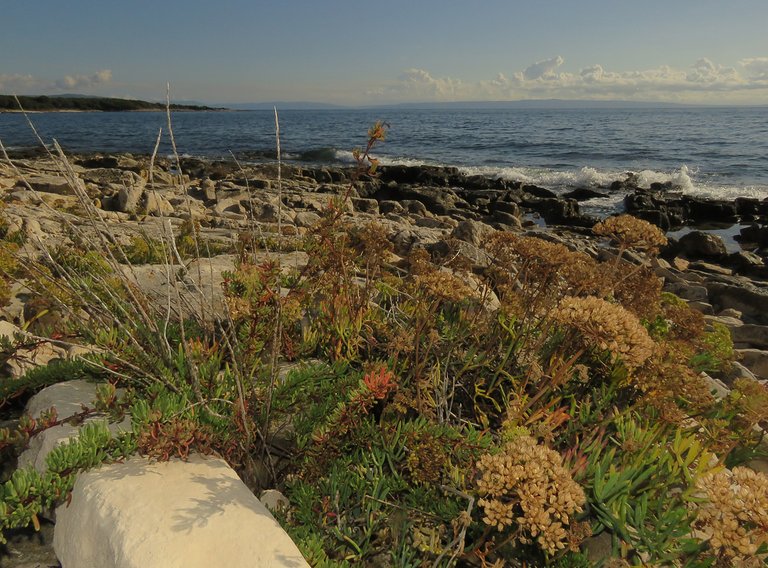
... and took a walk by the sea. Here, in a very different, well lit atmosphere ...
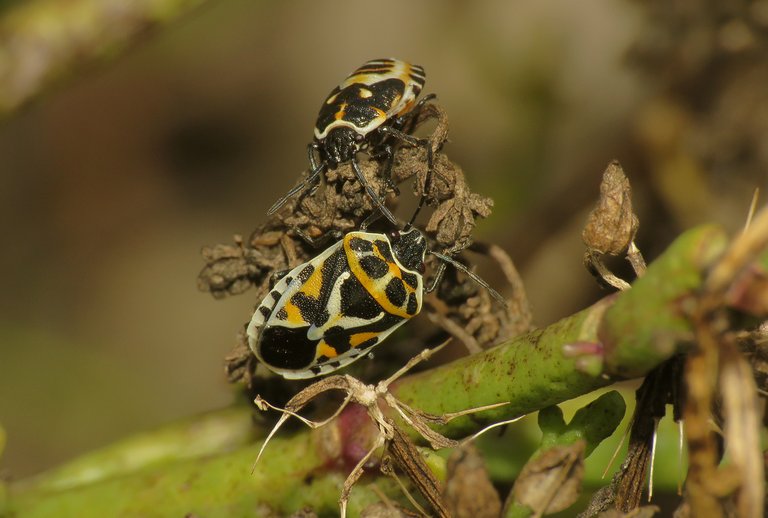
... I found the beautifully decorated Eurydema ornata bugs ...
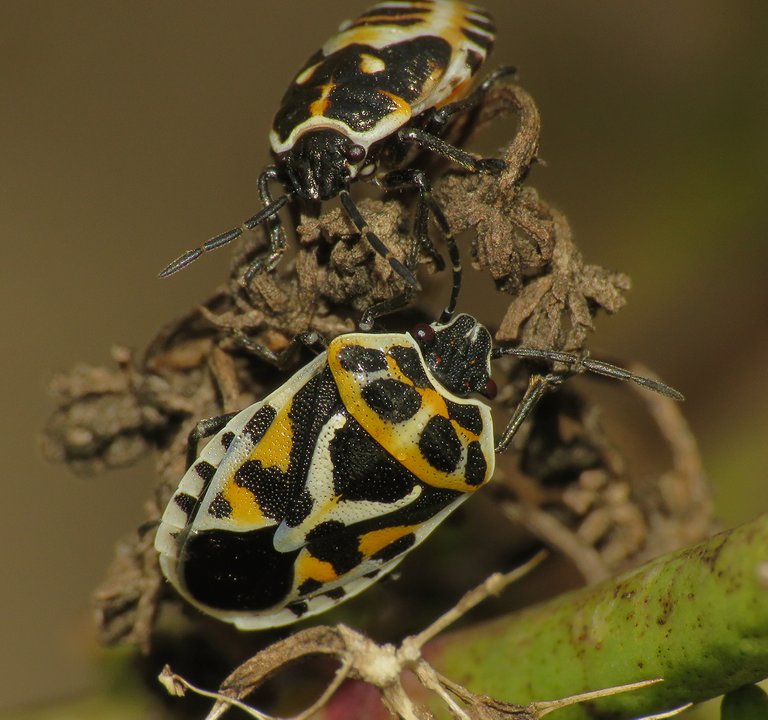
... crawling on the coastal vegetation ... the Crithmum maritimum and Inula crithmoides plants that grow in small gardens between the rocks in the tidal zone. Here you can an adult and the nymph. These two bugs have the same arrangement of colors ... but color in this species can vary. I found a few different versions of Eurydema ornata on this occasion ...
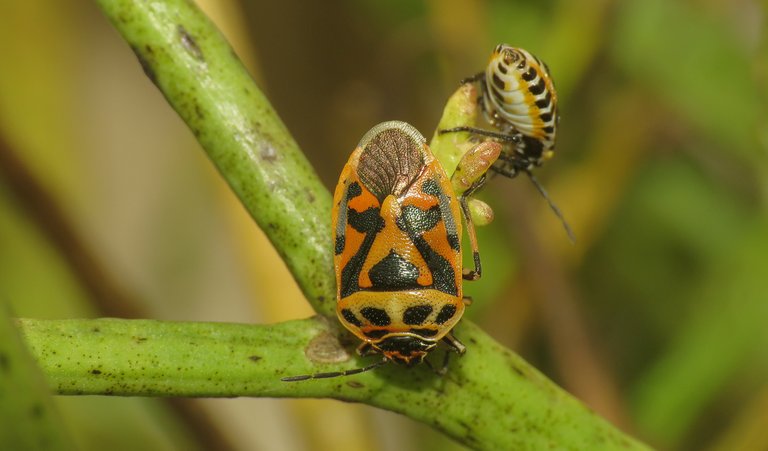
... so I took a few shots ...
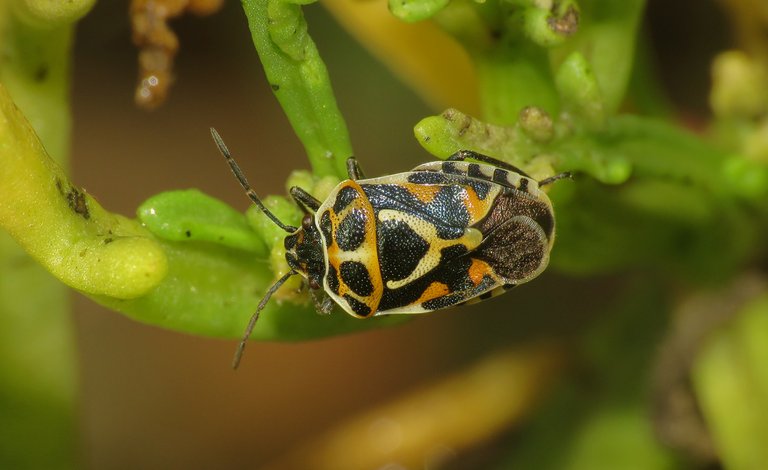
... to show this variability.
High between the reeds, above this buggy habitat ... the pumpkin spider has built a large web with the nice open view.
It's a pretty big and colorful spider ... and I don't know the exact species.
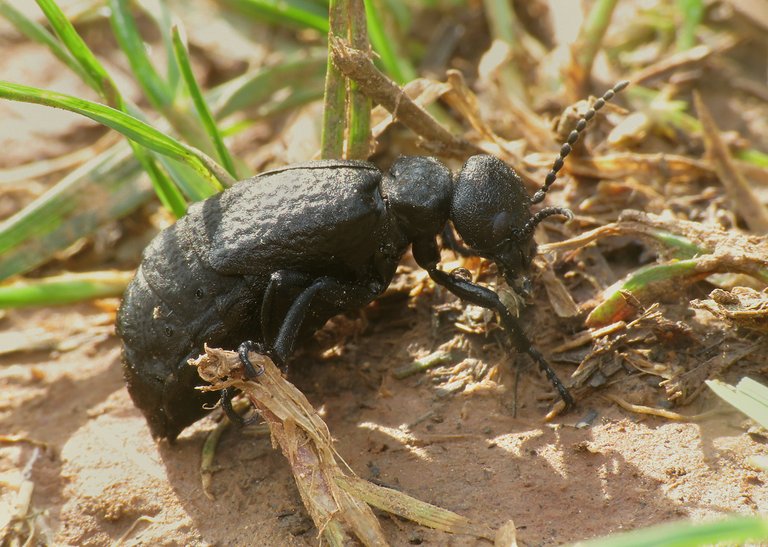
I encountered this Meloe proscarabaeus beetle on the small roads that leads to the forest ...
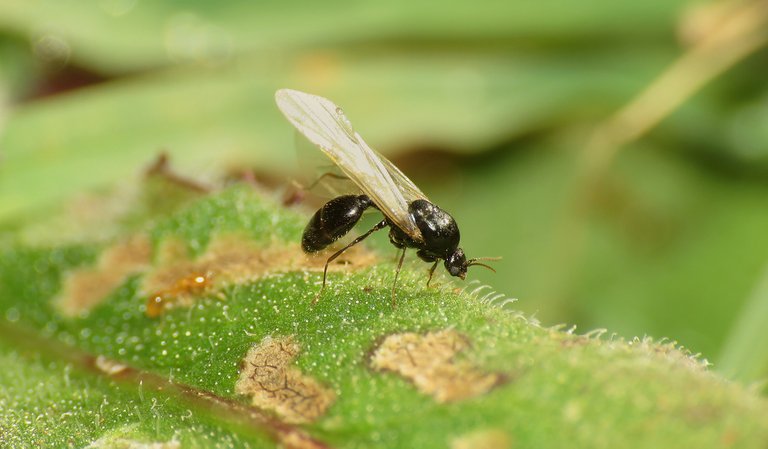
... and this winged ant was resting nearby ... on the vegetation that grows along the road.
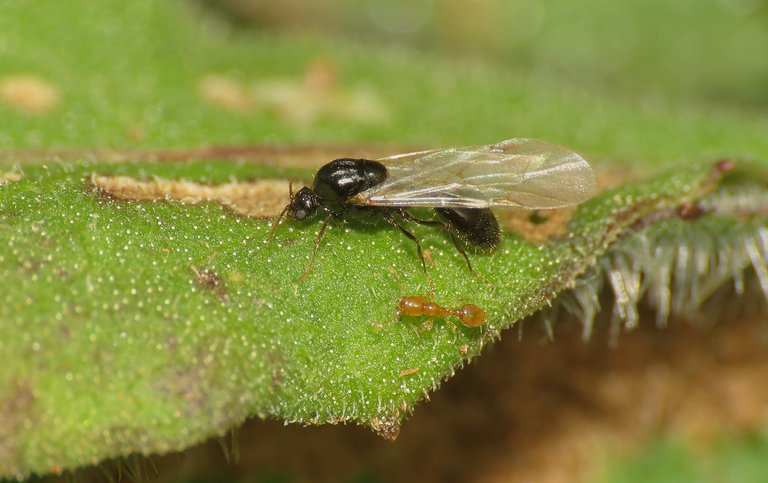
A much smaller yellow ant passed by ...
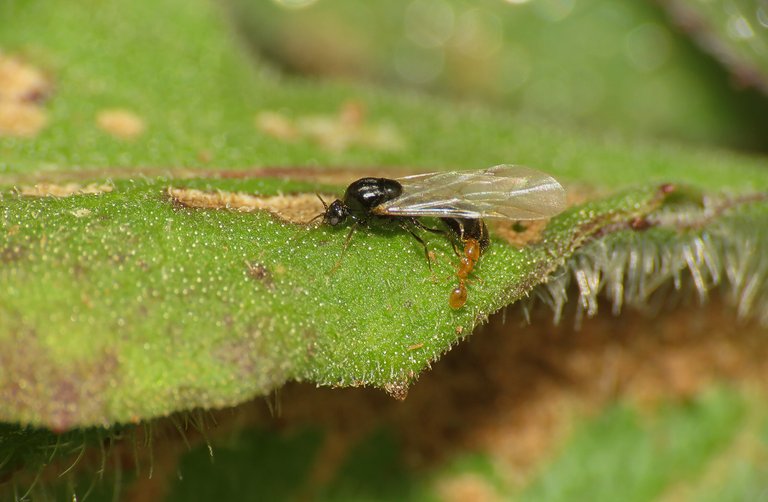
... and I witnessed a short interaction.
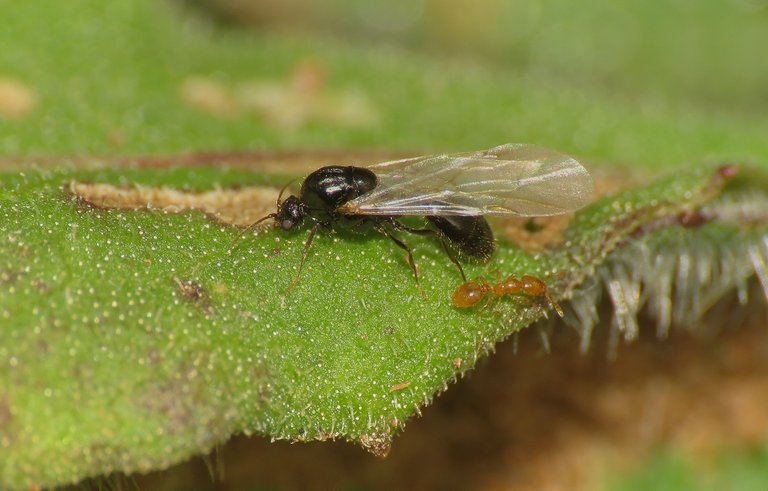
After this shot I left the ants ...

... and the coast ...
... ready to enter the forest again.
The third episode of the series, was the only one without any Amanita pantherina in it. And now ... after the short break ... this beautiful & potentially very dangerous species is here again. The reason for so many Amanita pantherina mushrooms in these posts, is that they can look pretty different ... and quite photogenic in different ways. This one grew in a dramatic pose under the Laurus nobilis sprout.
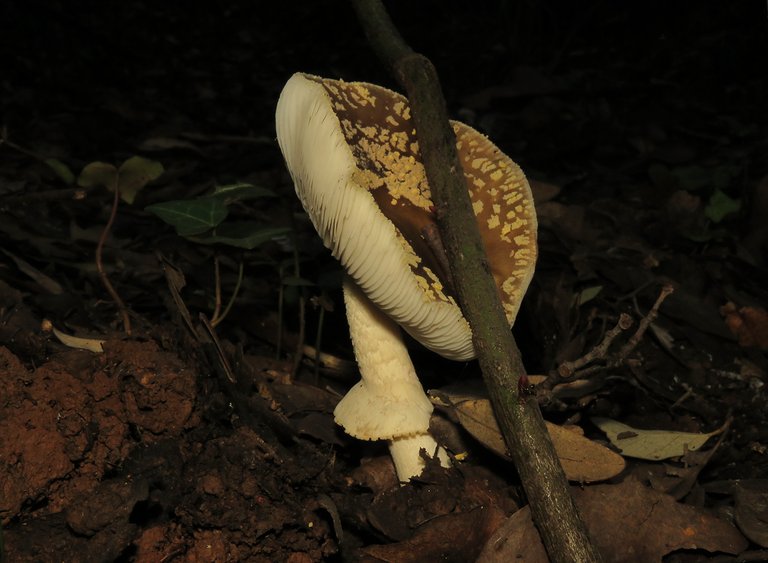
From this angle you can take a good look at the iconic spotted cap.
Here is another angle ... and a different view of the same elegant mushroom.
This group of large, robust mushrooms forming an interesting natural sculpture, already appeared in the post two times ... seen from a slightly different angles.

They often appear in a series of pairs ...
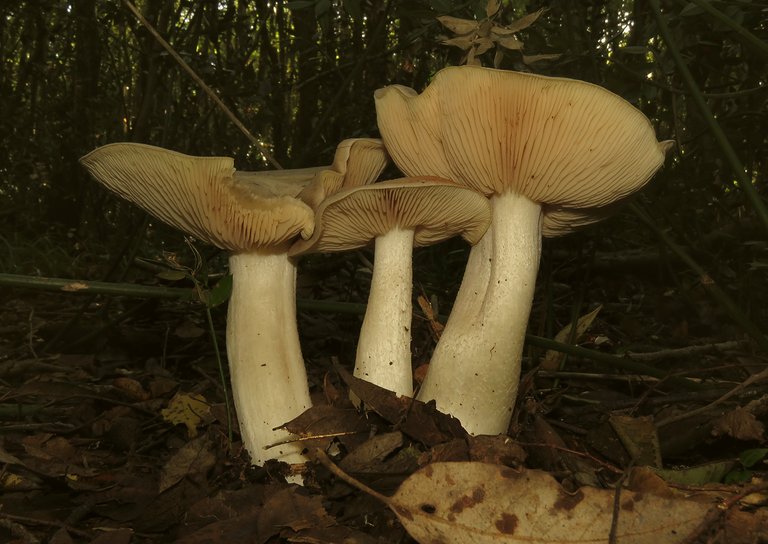
... trios ...
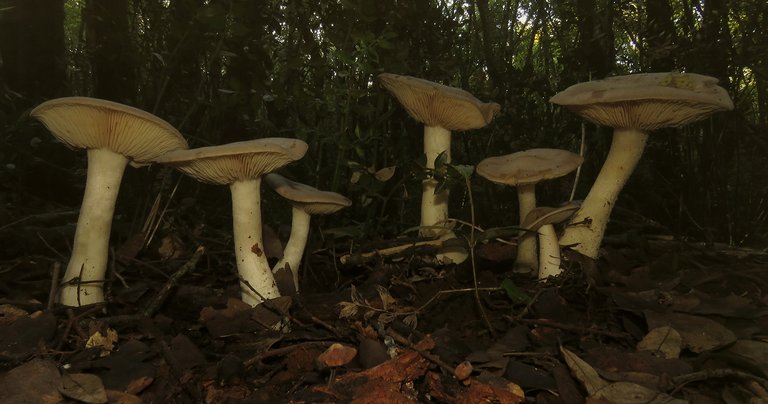
... and various kinds of small groups ...
... spread over considerably large parchments of the forest floor ...

... creating a lovely spectacle ...
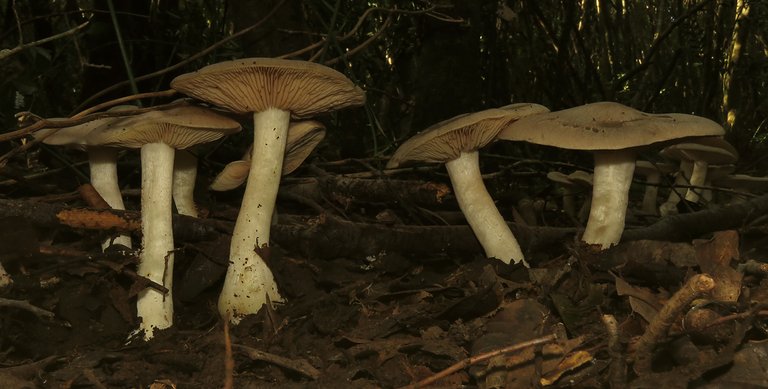
... in the deep dark corners of the woods.
And here comes the fourth ... and last appearance of the most iconic group of these mushroom I ever found ... with the twinkling sun this time ... shining through a wall of dense vegetation. On the following shot ...
... that group is in the background ... leaving the prominent place to another large, robust species ... still unknown to me. While photographing the mushrooms on the ground ...
... I was surrounded by some colorful fruits ... that were growing on shrubs above me. The small Smilax aspera berries ...
... and the considerably larger, edible berries of the Arbutus unedo. These fruits taste really good ... but if eaten raw too often or/and in big quantities they can create some digestive problems ... in the form of Homemade marmalade you can eat them more comfortably, with fewer restrictions.
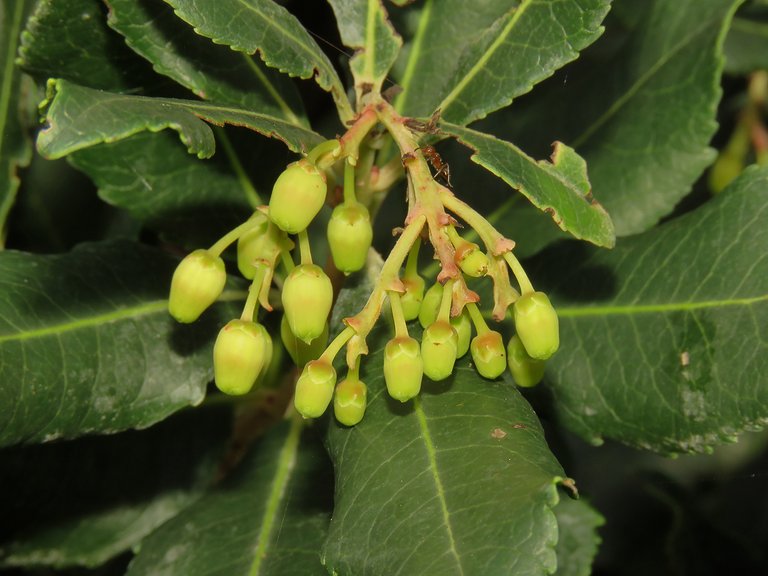
These are the small flowers of the same plant ...
... and here is a wider view on the Arbutus unedo shrub.

On this shot ... back on the ground ... you are watching a strange and colorful fungus ... the small, still developing Ganoderma lucidum.
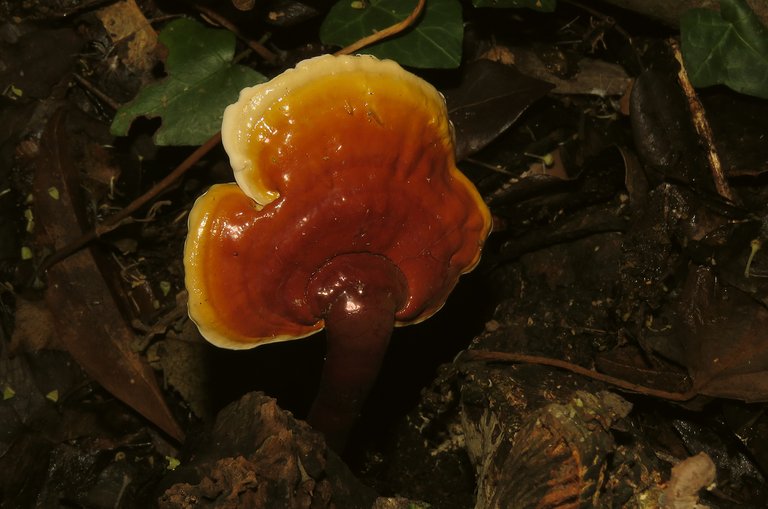
This one is larger ... and has already the typical fan - like shape.

Only this year I learned that they are good for tea. Didn't try it yet ... but I will.

Here you can see another Clavarioid fungi ... they appear regularly in these series ...
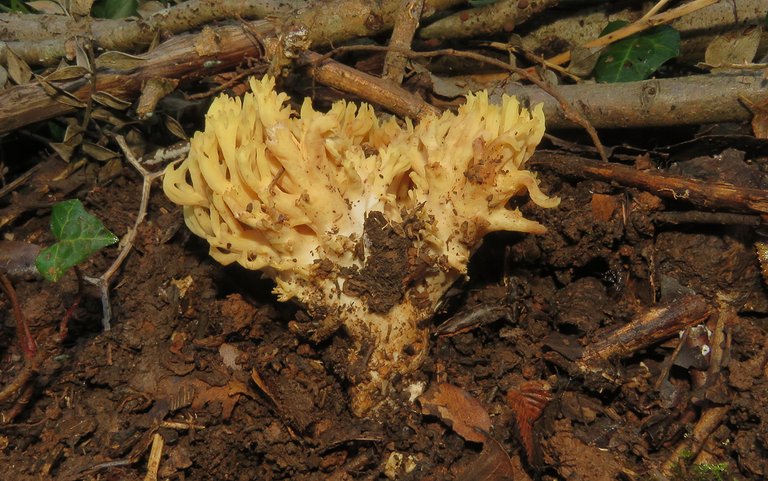
... this is some lovely, golden species.
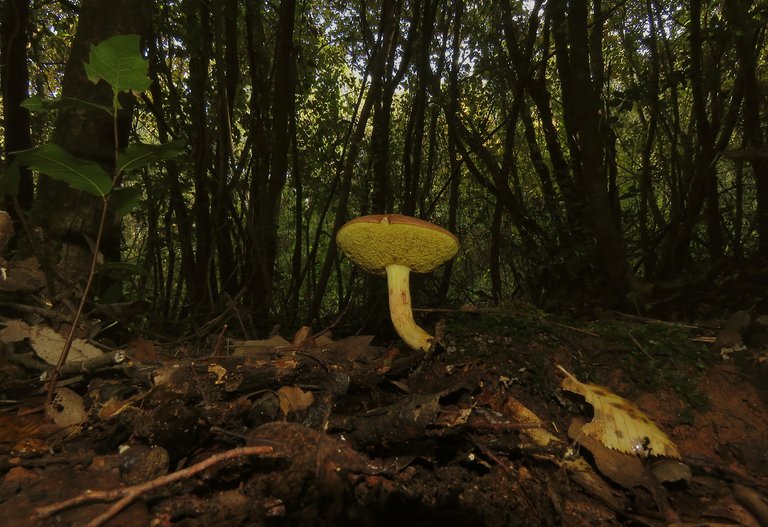
Here you can see the Xerocomus subtomentosus ...
... another edible bolete species.
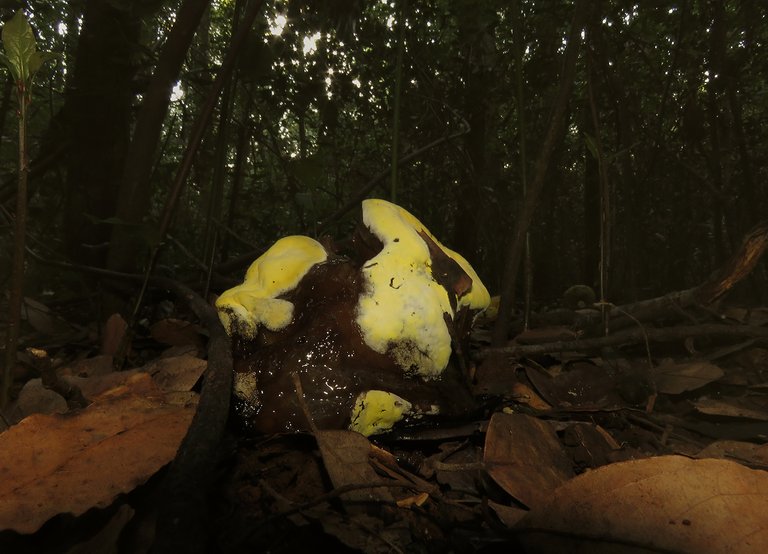
On this shot, some undefined but almost defined bolete ... probably the Leccinellum lepidum ... is slowly dissolving ... covered with patches of Hypomyces chrysospermus fungus, commonly and quite appropriately known as the bolete eater.
The small Panaeolus cinctulus usually look pretty unremarkable ... but here, while posing in the grass, they look pretty cool.
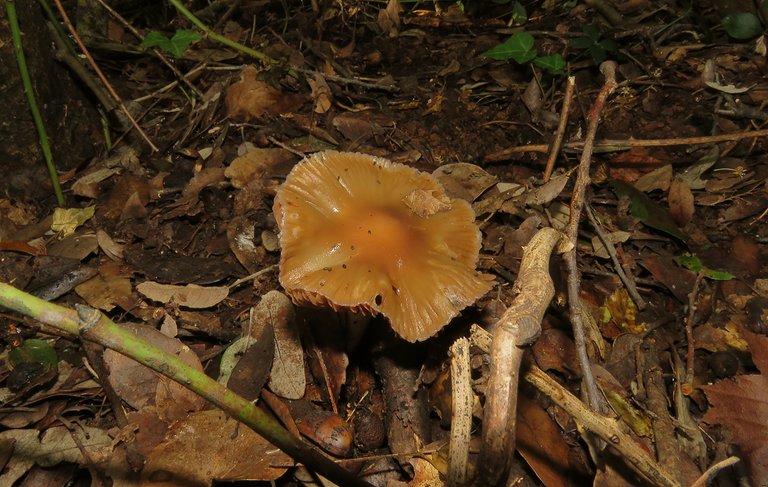
Here is another relatively small mushroom ... seen from the walking prospective ... from above ... I don't know what species is this. On the following photograph ...
... you can take a good look at some minuscule fungi, for a change. And again ... I can't tell you the name of the species. It's very small and I never noticed that thing before.
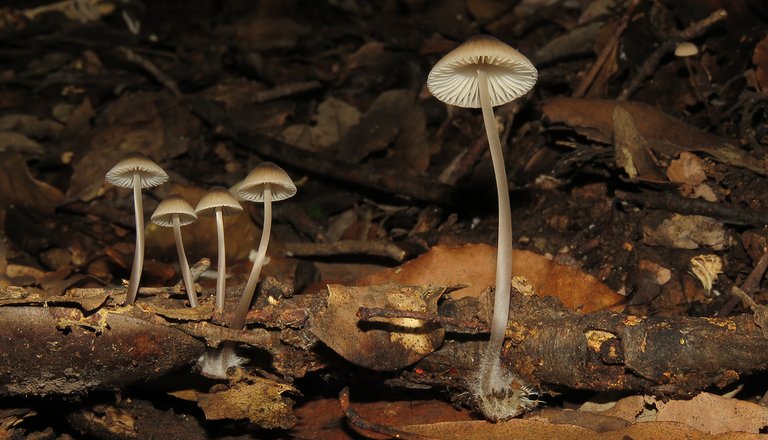
These small Mycena mushrooms .... are maybe or even probably the Mycena inclinata mushrooms ... but... he, he ... I didn't use this catchphrase for quite some time - but who knows ...
The elegant mushroom on this photograph looks kind of similar ... but only at first site ... this is the much bigger - Amanita fulva.
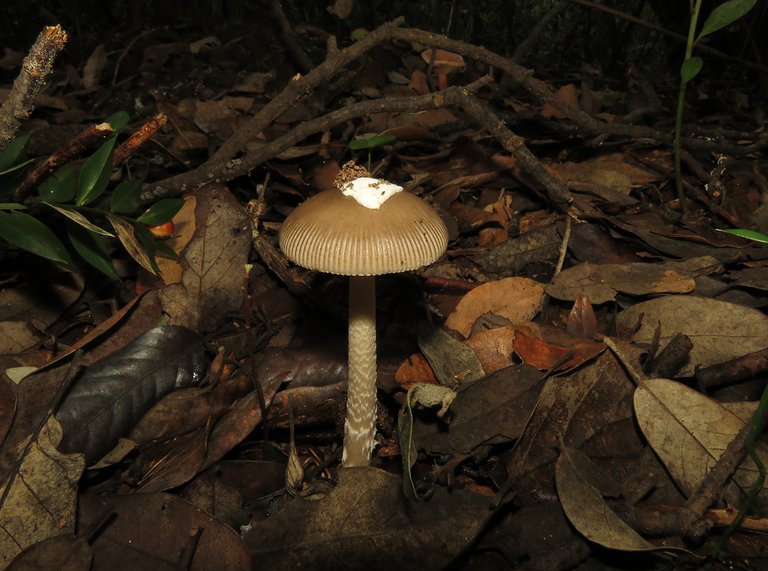
Like many related mushrooms, they grow from an egg - like envelope ... that sometimes leaves a white patch on the top of the cap ... very different from a multitude of small fragments of envelope that decorate the most iconic Amanitas - muscaria and pantherina.
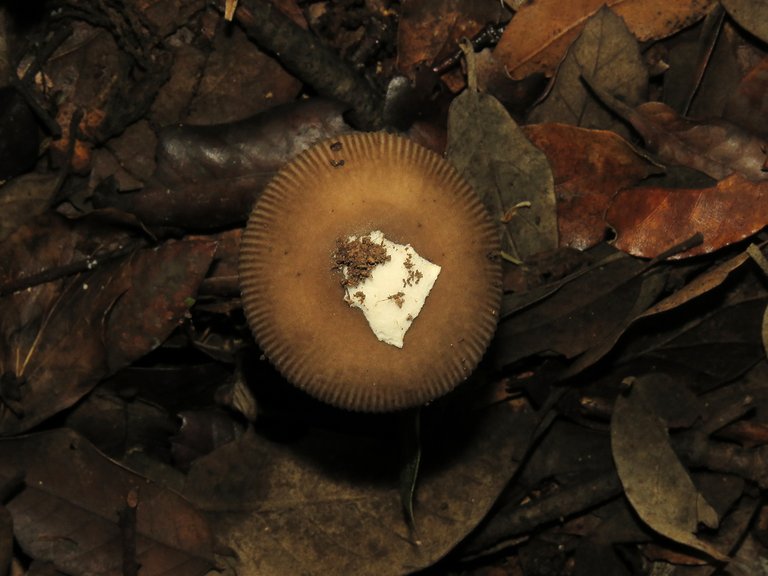
Here you can see how it looks from above.
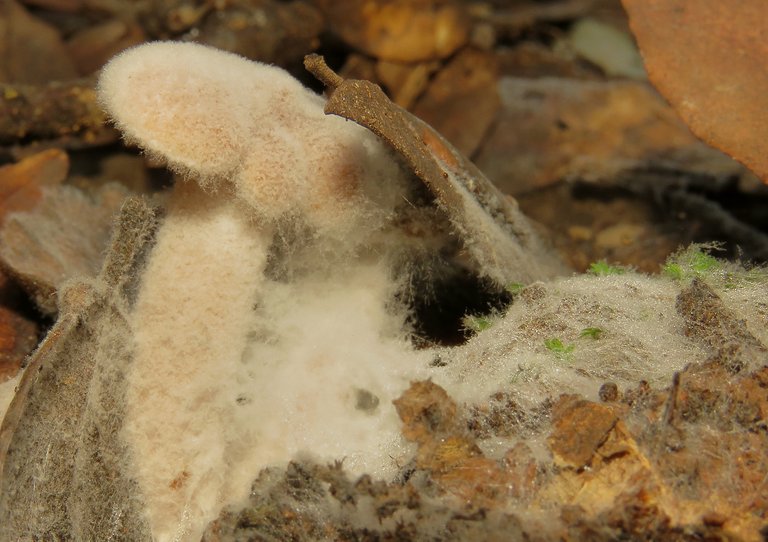
This small unidentified mushroom is covered by a thick layer of some mold or mold - like fungus.
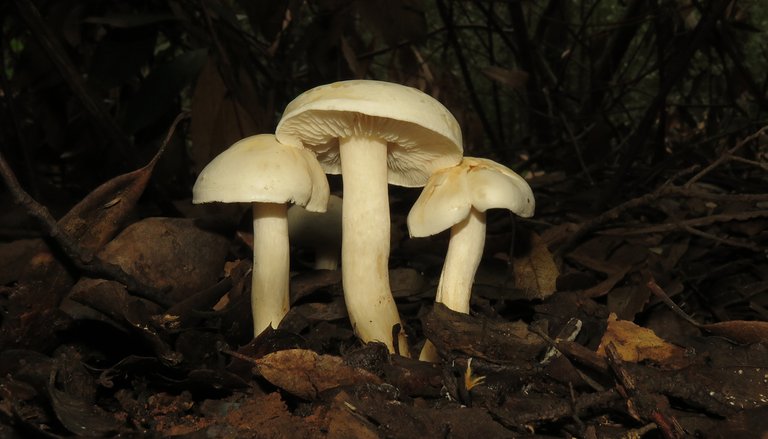
These small group of white Tricholoma album mushrooms ...

... looks like a bunch of ghosts in this dark environment.
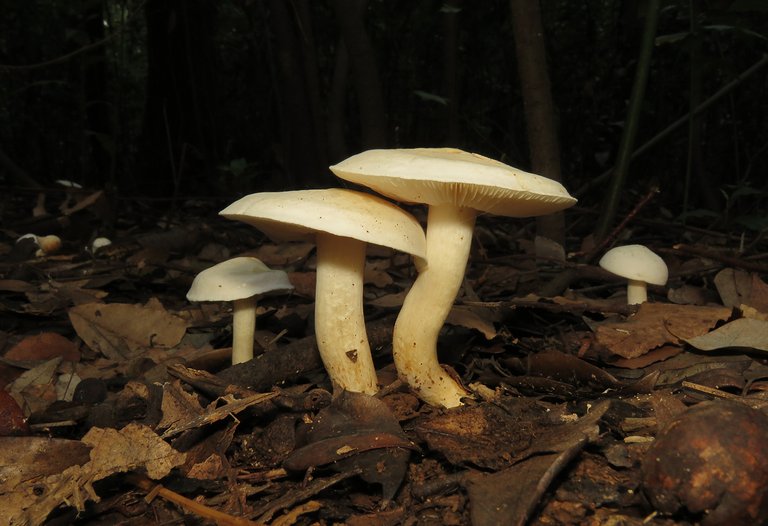
This is a poisonous species ... non - lethal most of the time ... but still capable to provoke serious problems, pain and damage.
Here you can see a group of these ghostly white mushrooms ... surrounding a different, brown species.
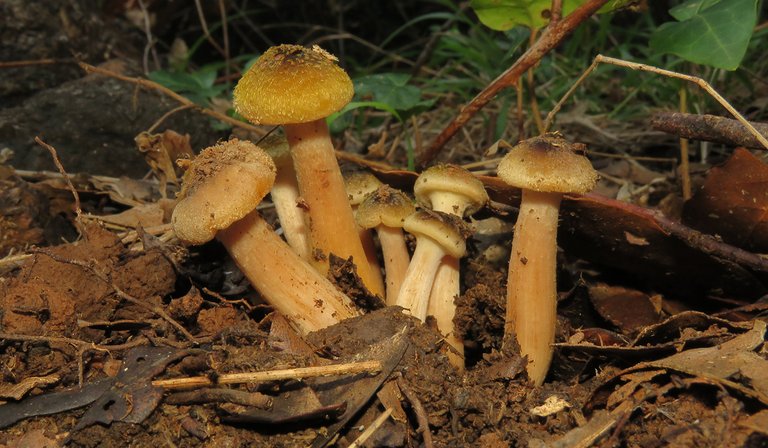
Young Armillaria mellea ...
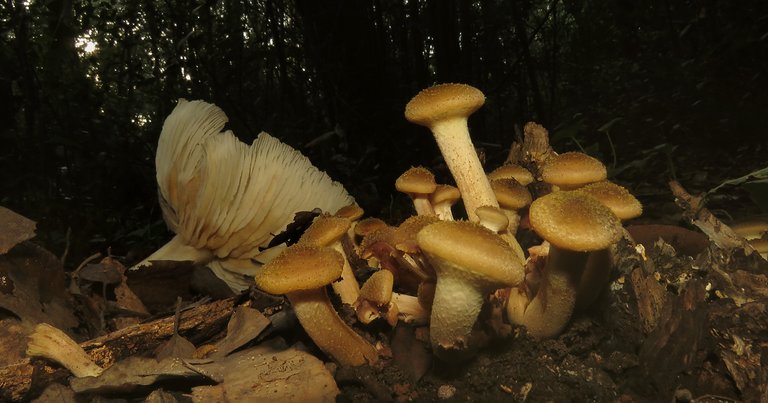
... are sprouting in groups ...
... ... around old, rotting stumps.

Sometimes these groups can be very large. And now ...
... with this interesting edible species, the post has to end - THE END.
As always in these posts on HIVE, all the photographs are my work ... and all were taken in between 22 and 25.10.2020.
I'll put all posts of this series on Pinmapple, because there is no better way to explain where in the world this interesting forest is.
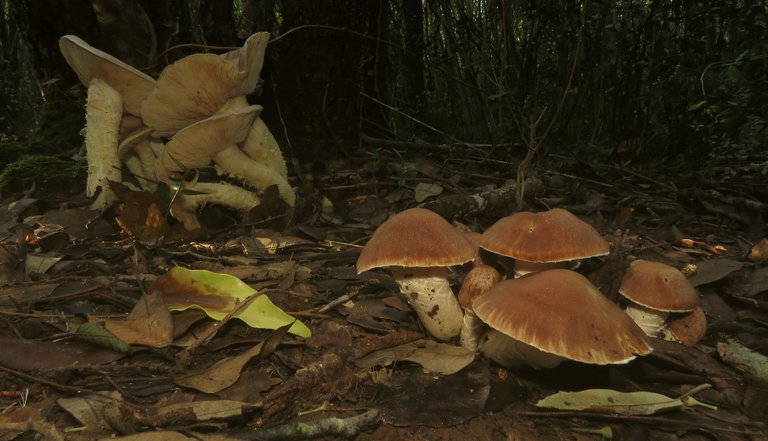
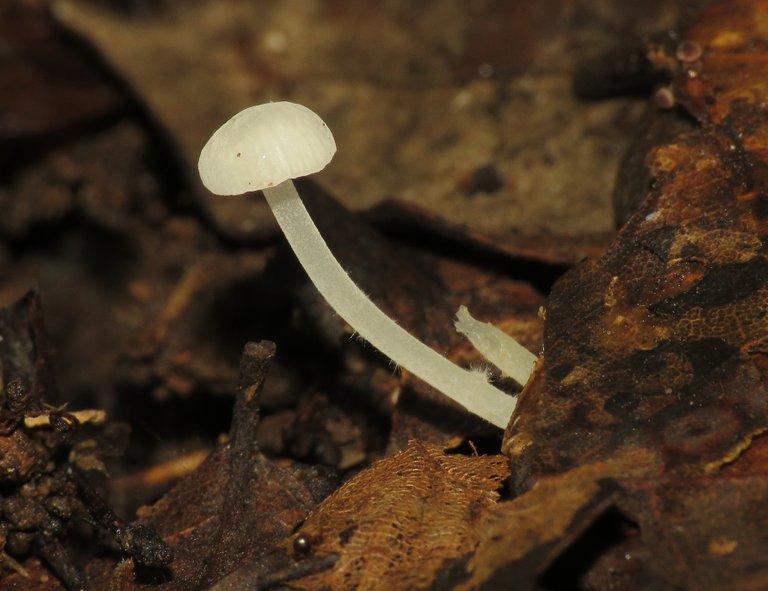
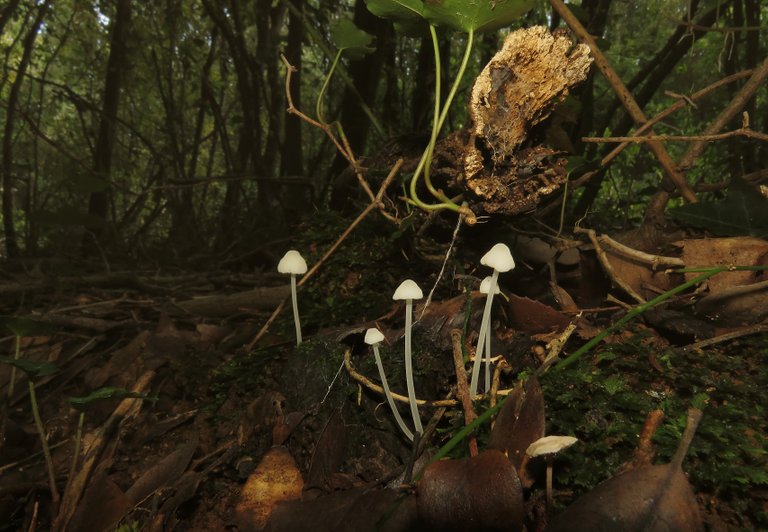
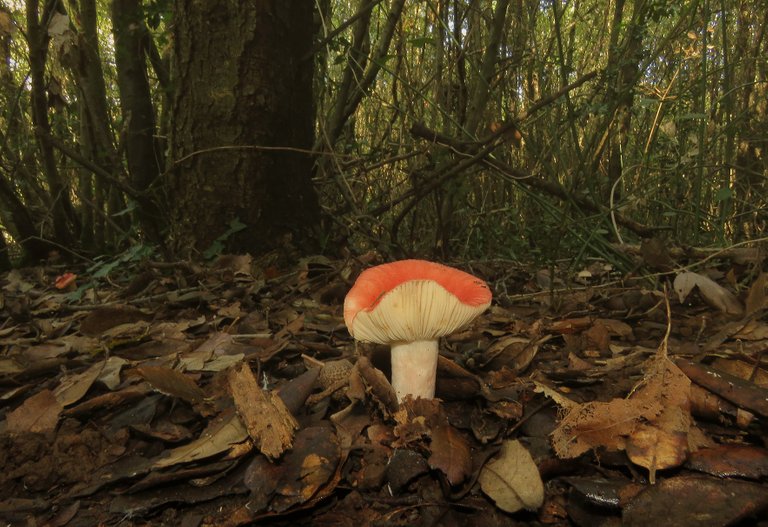
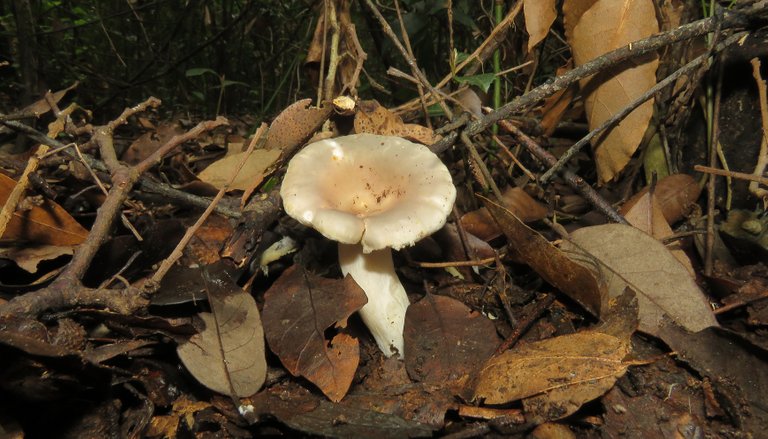
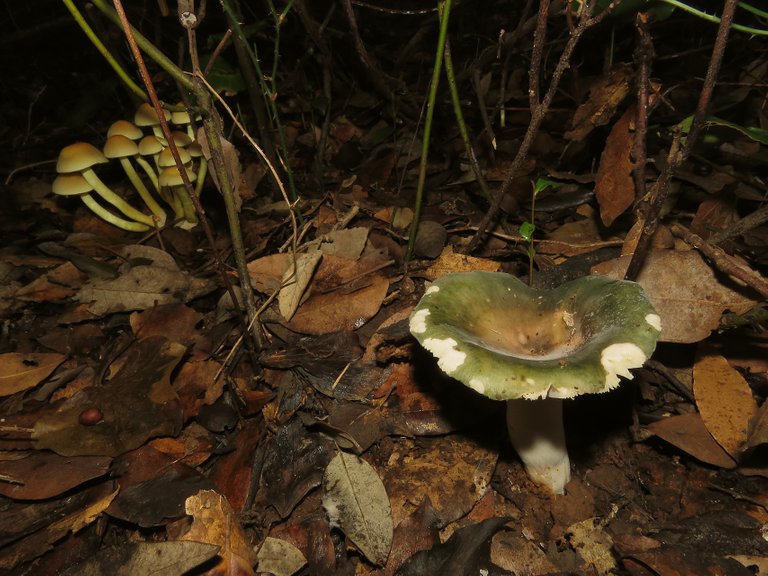
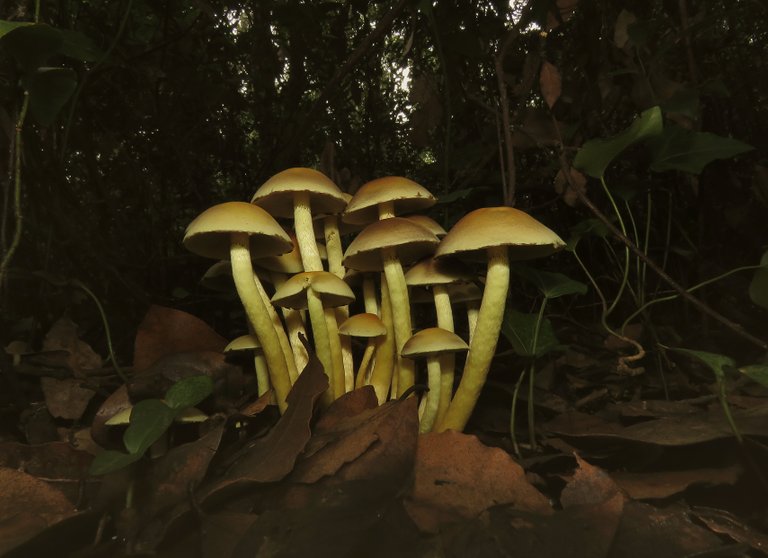


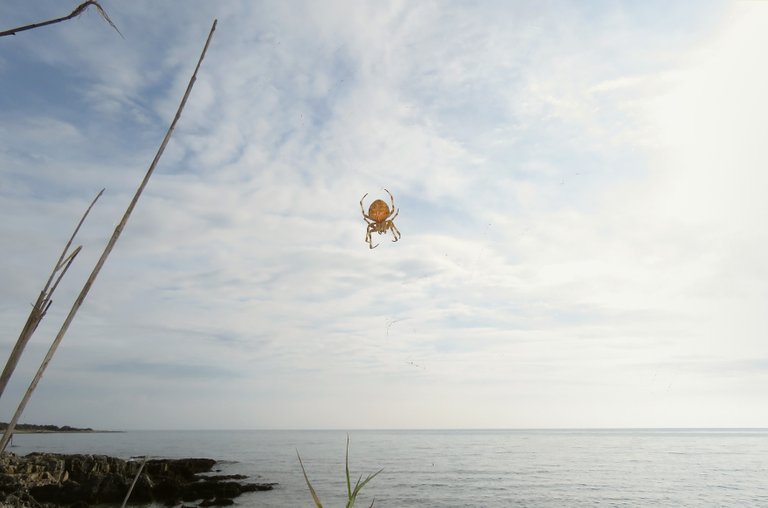

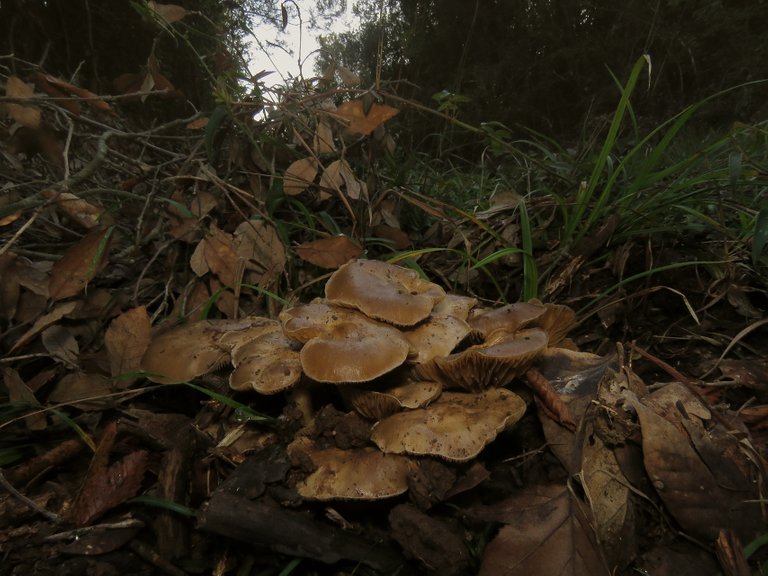
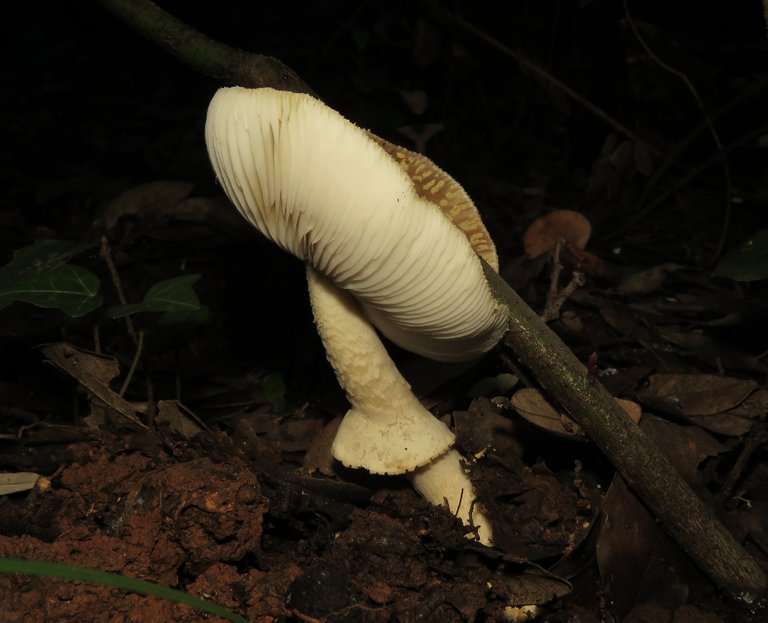

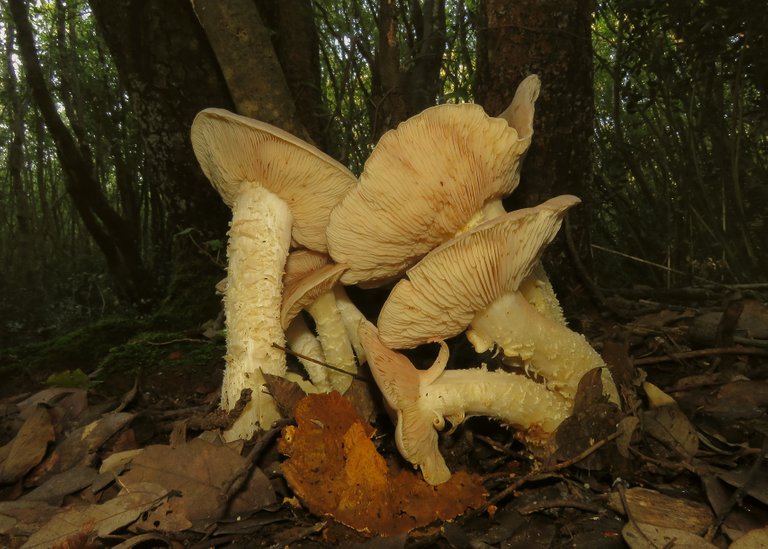

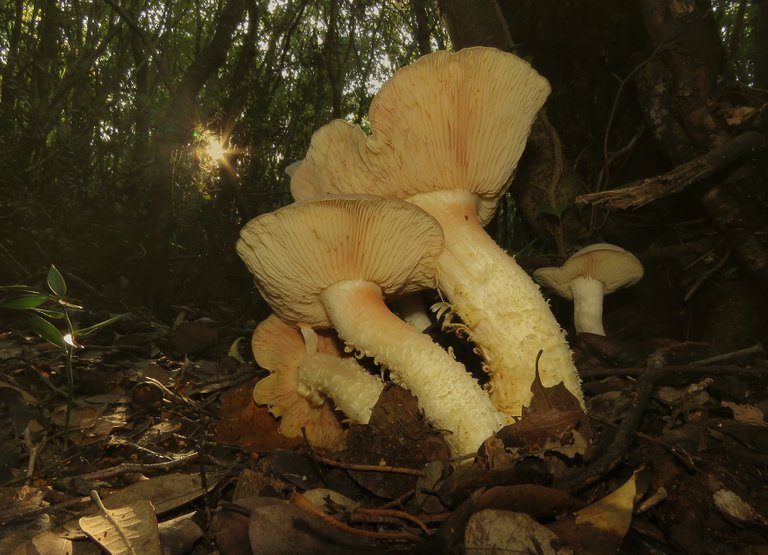


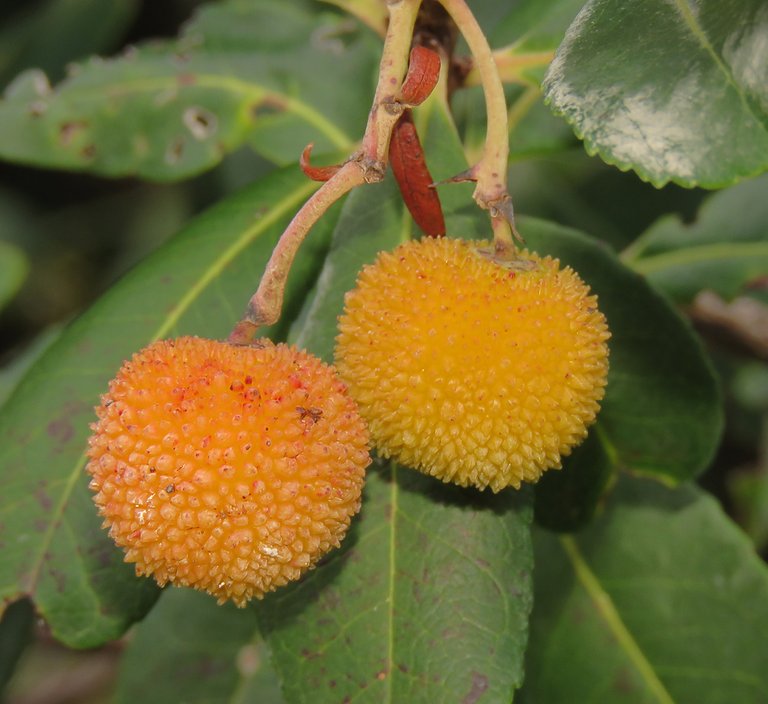

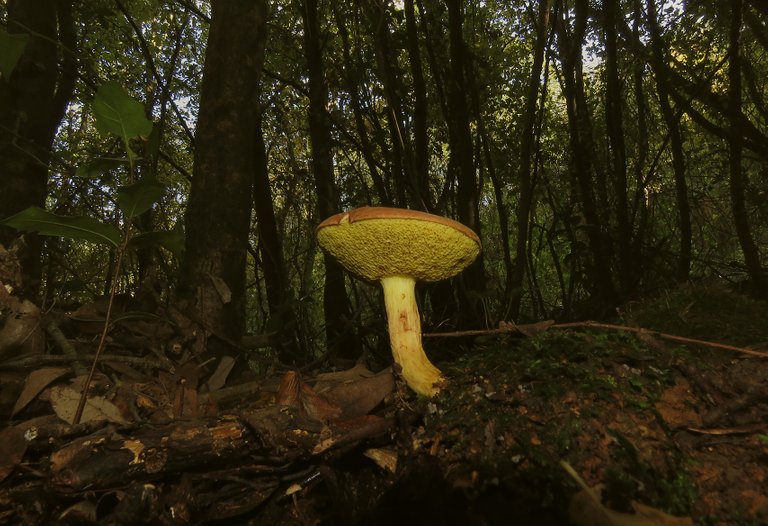
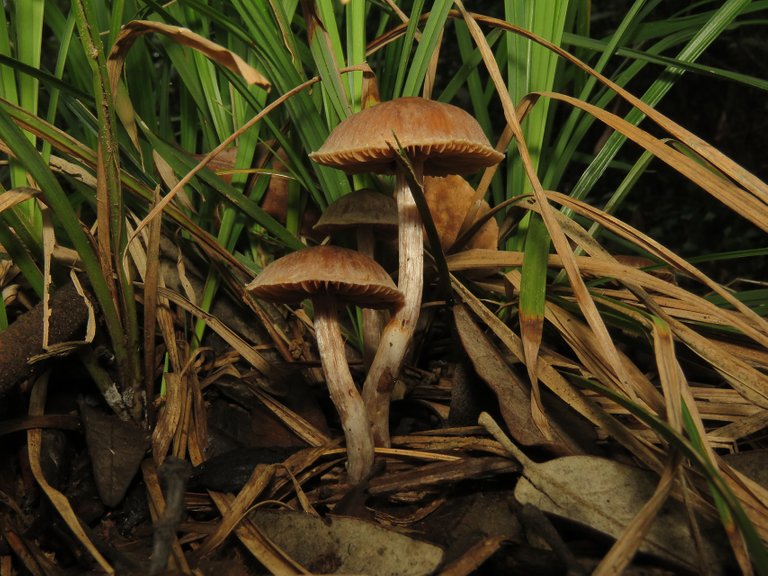
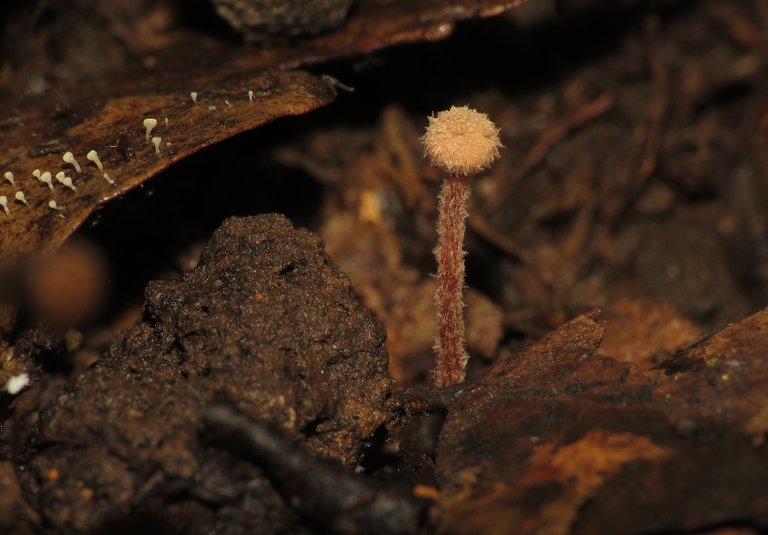
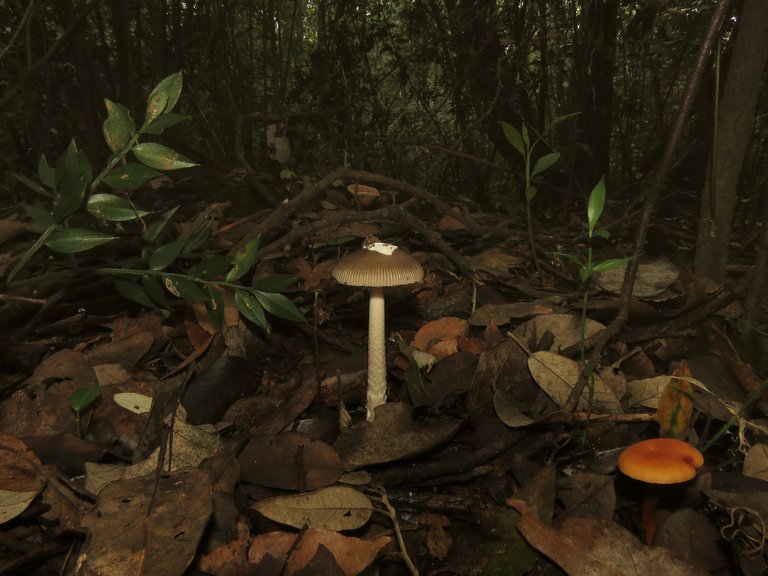
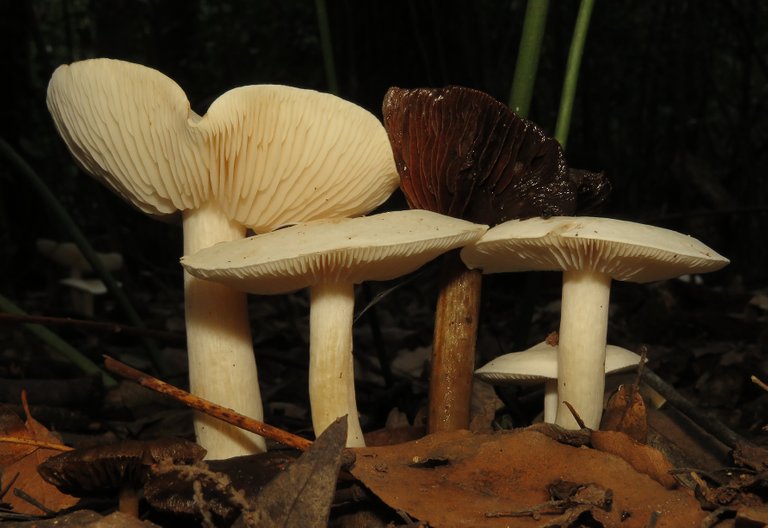
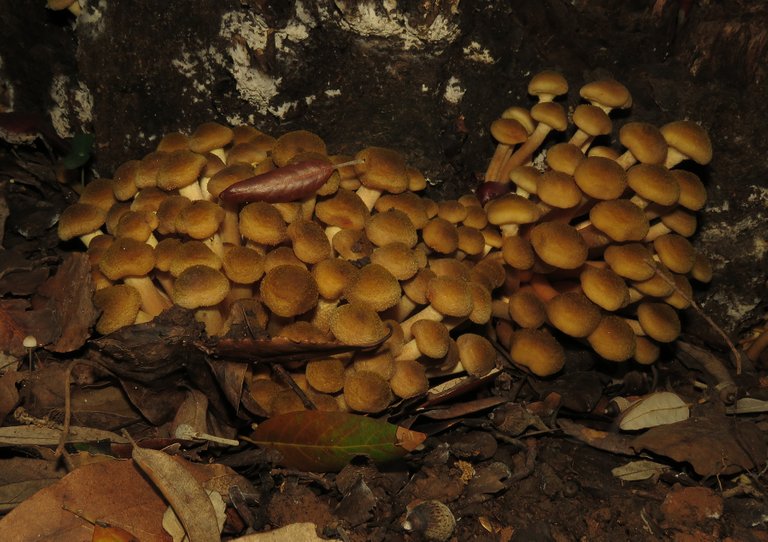

Amazing beautiful nature... :)
Congratulations, your post has been added to Pinmapple! 🎉🥳🍍
We are giving away 2000 Hive for reaching 1000 travel digests
Anyone and everyone can join!
Join the raffle and check the 1000 contest post
Did you know you have your own profile map?
And every post has their own map too!
Want to have your post on the map too?
Congratulations @borjan! You have completed the following achievement on the Hive blockchain and have been rewarded with new badge(s) :
You can view your badges on your board and compare yourself to others in the Ranking
If you no longer want to receive notifications, reply to this comment with the word
STOPTo support your work, I also upvoted your post!
Sorry, but this sentence makes me laugh, I am not making fun of you, it is simply that the photographs and the post are very detailed, so if it must end in END.
... with this interesting edible species, the post has to end - THE END
:)
Extraordinary work @borjan I love going through your publications. Greetings.
Thanks :) Glad you like these photo stories about nature in my area.
Another epic show of mushrooms and insects just awesome 👍
Thank you :)